We left the Nucleo Santa Virginia field station at 7:40 to sunny, hot weather, and arrived at the visitor centre of the Quilombo community known as the Casa da Farinha (House of Flour) located approximately 5 km north of Picinguaba. One of several communities of Quilombolo in the State of Sao Paulo, the Casa da Farinha is named for its production of cassava flour and consists of 53 families – approximately 260 people. There, we met the community elder, Joseph Pedro, father of 11 children, and a community leader and our guide for the day, Feliciano. The Quilombo community was established in 1888, when slavery was abolished in Brazil, by Joseph Pedro’s father and several other former slaves. These slaves were used to farm sugarcane, which was processed into sugar and then cachaça alcohol, which was then transported by ship to Africa (or Europe) to buy more slaves. After slavery was abolished, these slaves were left to fend for themselves and formed tight knit communities, called Quilombo. Pedro told us that this is the essence of the Quilombo – because they have little, they must work together and put the community first.
Nowadays, due to regulations placed upon them by the government limiting their economic activities, Casa da Farinha produces cassava flour to sell, made from manioc roots that they grow in their agroforestry farm. This process is powered by a large watermill, located on the site of the former distillery. The manioc root is first washed in a large tumbler powered by the watermill. This removes the skin. It’s grated to produce a mash, which is then pressed to remove the toxic sap. The toxic sap is used as a natural pesticide, which also serves to dispose of it without polluting the river. Finally, the mash is dried, resulting in a starchy, rich flour. This, along with fish and bananas, are the staple foods of the Quilombo community.
We then embarked on a 1.5 km walk on the Trilha Corisco. This trail links the Quilombolos of Casa da Farinha to the large town of Paraty, approximately 20 km north on the Baia Carioca. It cuts across the valley and the border between the states of Sao Paulo and Rio de Janeiro, transecting the Atlantic Coastal Forest and ending at the Estr. Velha do Corisco. We learned about plants such as the inhame – an inedible cousin of the manioc which has heart shaped leaves, and taioba – an edible relative that has split leaves. As the restinga transitioned to hill forest, the soil became thin and poor, called sega pehira. We saw tube roots, known as sapopemba, and learned about the medicinal uses of the nutmeg tree.
Heather, Megan and Emma gave their species accounts today, on Dicksonia sellowiana, Psidium cattleyanum, and Hymenaea courbaril respectively. Dicksonia sellowiana is an endangered slow growing tree fern that is exploited as fertilizer for orchids (another highly endangered and exploited group). P. cattleyanum is an often invasive, fast-growing tree that thrives in poor soils and a wide range of environments. H. courbaril is a nitrogen fixing tree that produces large red pods filled with an edible, musky pulp that is high in protein and starches.
After our hill forest hike, we swam at a waterfall pool for 15 minutes, and enjoyed a lunch cooked for us by community members back at the Casa. We then listened to a talk on the Quilombo community by Joseph Pedro, and then visited the agroforest, where the community grew most of their food. Agroforestry in the Quilombo community began with fields stripped of their nutrients and microbiota by monoculture sugarcane farming and clear burning. The ruined fields were initially treated with green fertilizers and planted with fruit trees (such as banana) for shade and moisture, potato for stabilizing the soil, and herbaceous plants to restore the microbiota of the soil. These plants are not harvested, only used to restore soil quality. Cassava, corn and beans are then planted, in a partnership similar to the three sisters of Canada’s indigenous peoples. The cassava provides structural support for the beans and winter shelter for the corn, while the beans enrich the soil with nitrogen fixation. Two crops of beans and corn are harvested for every cassava harvest. Our trip to the Quilombo community then ended with a traditional song and dance, led by the community’s children (a group called the Jongo no Quilombo da Fazenda).
- Ze Pedro expounding
- Amelia showing her dancing chops with a local
- Kayleigh with local youth
- Alex in the middle
- Jongo – dance with song and drumming
- The mill
- White-barred piculet
- Kayleigh and Darcey
- Riley
- Feliciano
- The mill
- Listening to Ze Pedro
- In the forest listening
- Swimming in the local river.
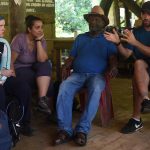
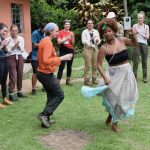
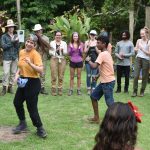
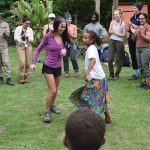
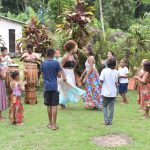
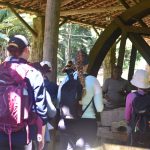
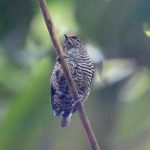







Leave a Reply